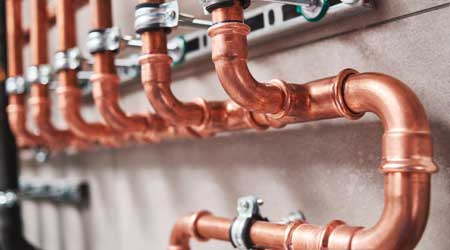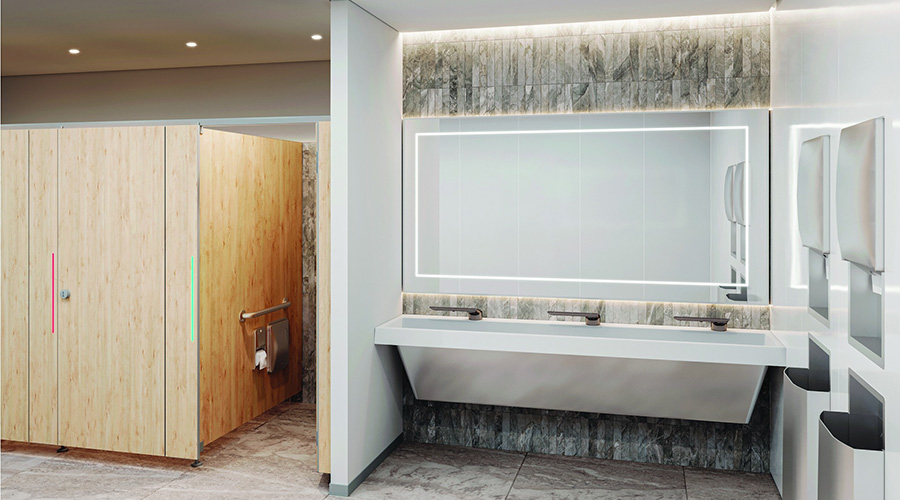3 Common Plumbing Mistakes Likely In Your Building
With pipes out of sight, don’t keep these problems out of mind.
Plumbing is central to the success of any building, campus, or facility design. If people are going to be living, working, or playing in a structure, they will need water to maintain and clean the building, prepare food, and to drink.
It can be easy to treat plumbing as an afterthought since plumbing systems are typically hidden behind walls and simply expected to work just as they do at home. Out of sight out of mind, right? In fact, this tendency to pay insufficient attention to the design of plumbing systems all too often leads to mistakes that can haunt building operations and, ultimately, require costly retrofits to get right.
What are the major considerations for building developers and owners as it relates to plumbing systems? A few key areas of focus will help make sure your building operates the way it should be from the beginning.
1. Under pressure
The most common plumbing issue revolves around water pressure. One of the major objectives in designing a building water system is to ensure that there’s sufficient water pressure all the way along the line, including at the furthest fixture. The larger the building, the bigger the challenge to provide sufficient and consistent pressure throughout a structure. For a 25-story office building, that means water may need to travel at least 300 feet vertically while maintaining water pressure all the way to the end of the line. That’s no small feat.
Wrapped up in the pressure discussion is demand. How does a building, for example a hotel serving a conference center, that has high demand in the morning and evening hours, modulate to provide the right pressure when demand spikes?
It is imperative your mechanical engineer properly size your pumping and control systems to supply adequate GPM and head pressure for this wide range of needs. The most common mistake we see in field installations with issues are a lack of proper equipment and controls that can react to the wide variance in use. Undersized pumps, insufficient controls, and inadequate pipe sizes can all lead to expensive rehabilitations for owners and building operators.
One of the foremost challenges is determining how much pressure will be needed when the building is fully occupied. All designs start with the supplied city or well pressure, and then designing to the building’s needs. Depending on the type of facility, this demand can vary radically.
No two building projects are alike which requires mechanical engineers to understand the specifics of the building to craft the right approach to meet the unique challenges and opportunities presented at the site.
For most buildings, water pressure is solely an operational issue to be solved, albeit expensively. But in mission critical operations, such as at hospitals or public safety facilities, buildings can’t afford to lose water pressure. Not only can this impact emergency services requiring running water, but it can also lead to contamination of the water that does flow. For these buildings, water pressure isn’t just a matter of expense, it can be a matter of life and death.
2. Potable water
If pressure and delivery is the most talked about plumbing system, water quality is right behind it in terms of its effect on your building and the people occupying it. Taste, hardness, and maintenance from deadly bacteria are all important considerations in the development of a plumbing system.
Most jurisdictions provide safe potable drinking water to the public, but it doesn’t necessarily have to taste good. In some areas, Florida for instance, owners have to deal with challenging circumstances, where solids and odors from their water can cause significant tenant complaints. With the help of mechanical engineering teams, many make the choice to install building-wide water treatments systems that strip the contaminants from the water source and re-add minerals to provide a better experience.
Water hardness too, plays a big role in the water quality treatment from an owner and developers’ perspective. Hard water is high in dissolved minerals, particularly calcium and magnesium. The harder the water, the more likely it is to fowl hot water heaters, piping and fixtures. A mere hundredth of an inch of scale built up in a heat exchanger can decrease performance significantly, from 20 percent to 45 percent (even more in extreme scenarios), increasing operational cost and affecting the overall lifecycle of your system. A simple treatment system, often in tandem with the system that treats the water for taste, can eliminate these headaches when considered in the design process.
Another important issue related to potable water is legionella. Water is always treated as it comes into the building, but if it sits in pipes for too long, the deadly bacteria can accumulate in those pipes.
Legionella must have very specific conditions to live, one being stagnant water, and the other being a specific water temperature range. National plumbing recommendations for best practice specify that water storage tanks (where water can sit for a period of time) stay at 140 degrees — a temperature at which legionella cannot survive — but be careful, this isn’t a minimum. Legionella can live in water both below and above that 140-degree marker.
The other important step is to make sure your water systems, particularly hot water systems, recirculate regularly. This will keep the water in your pipes from becoming stagnant and allowing the development of the bacteria. Simple, but effective ways to keep your water systems safe.
3. Hard water
A third, and final, issue facing many buildings is hard water. Hard water is high in dissolved minerals, particularly calcium and magnesium. The harder the water and the more it is untreated, the more likely it is to foul hot water heaters, especially tankless hot water heaters.
A mere hundredths of an inch of scale built up in a heat exchanger can decrease performance significantly, from 20 percent to 45 percent (even more in extreme scenarios), increasing operational cost and affecting the overall lifecycle of your system. This can be an expensive issue to live with, minimizing the value of the dollars you are using to operate your equipment. With this problem, you are continually throwing those dollars away. Depending on the size of your equipment this may only be pennies on the dollar, however, when you are heating thousands of gallons of water a day, those cents add up quickly.
Hard water can also lead to premature replacement of hot water heaters, balancing valves, and other hardware. The larger the building, the larger and more expensive the solution.
When designing plumbing systems for new buildings or complexes, it’s essential to test your water quality. If necessary, your MEP engineers can develop strategies for treating the water as it enters the building and for maintaining water heating tanks properly.
When developing a new building or complex, it’s important not to treat plumbing as an afterthought. In addition to traditional plumbing considerations about how to lay out plumbing infrastructure and integrate it into the operations of the building, it’s essential to pay attention to these three areas that are often missed. Water pressure and water quality play a huge role in the perceived success of a project and can have meaningful impacts on the operations and bottom line of a facility.
If not addressed correctly from the beginning, it can lead to the need for costly equipment repairs or replacement. It’s essential for projects to rely on an engineer who understands and practices with these systems regularly to make sure your project is set up for success.
Tom Bernard is MEP Market Leader for WGI Inc. He can be reached at Thomas.Bernard@WGInc.com.
Related Topics:












